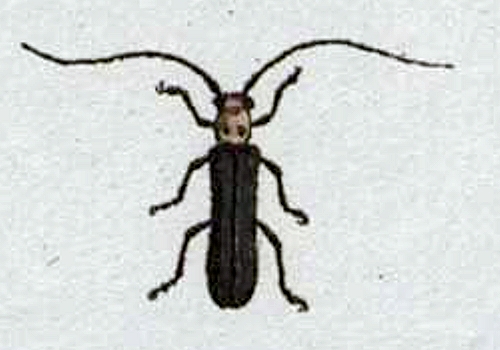| Author |
 Topic Topic  |
|
|
Percy
Member Nathrius
Peru
1 Posts |
 Posted - 09/02/2015 : 17:37:11 Posted - 09/02/2015 : 17:37:11



|
Estimados amigos,
estoy en busca de información de Oberea bimaculata (Biología, Daños, hospederos, distribución geográfica, impacto, control)
muchas gracias
Percy
solproduce@gmail.com |
PMS |
|
|
Xavier
Scientific Collaborator
    
France
12219 Posts |
 Posted - 09/02/2015 : 22:19:37 Posted - 09/02/2015 : 22:19:37



|
| I wonder if it is a valid species ?... |
 |
|
|
Larry Bezark
Member Macrodontia
    
USA
2238 Posts |
 Posted - 09/02/2015 : 22:26:02 Posted - 09/02/2015 : 22:26:02



|
It is a synonym of Oberea perspicillata Haldeman 1847.
The species occurs in the Eastern United States, west to Utah and Texas.
Larry B. |
 |
|
|
Francesco
Forum Admin
    
Luxembourg
9454 Posts |
 Posted - 10/02/2015 : 10:31:20 Posted - 10/02/2015 : 10:31:20




|
Actually, Oberea perspicillata Haldeman 1847 is a synonym of Oberea bimaculata (Olivier, 1795).
Cf. Breuning (1962-3) - Révision systématique des espèce du genre Oberea.
This species was described on the basis of a beetle introduced in France (Var). Below the original drawing:

Saperda bimaculata Olivier, 1795 in Olivier, 1908
No European species shows this pattern (red head and 2 pronotal spots)
Linsley & Chemsak simply did "not accept the premise that the species was an import from the US" as stated by Horn (1878) and all subsequent authors, without furnishing any explication.
Unfortunately, these guys forgot that they also must follow International Rules, not own ones; hence, the valid name is the first that was published. 
Here you can freely read some news (as perspicillata  ). ). |
 |
|
|
dryobius
Member Rosenbergia
   
USA
1887 Posts |
 Posted - 10/02/2015 : 14:33:31 Posted - 10/02/2015 : 14:33:31



|
| I support Linsley & Chemsak's view. There is no holotype of O. bimaculata to verify that it is ABSOLUTLEY the same species which in the Eastern USA. And since the description of O. bimaculata does not list the USA or even North America, then O. bimaculata is certainly a questionable species that nobody will ever know with certainty. There are other North American Oberea which somewhat resemble the illustration by Olivier, however it does resemble perspicillata more than others. Linsley and Chemsak also stated that it is possible that the species which we now call O. perspicillata in the USA is actually a complex of several species (multiple host plants and numerous varieties). That is another reason why we should not retain the name of O. bimaculata for anything in the North American fauna. Just my opinion... take it or leave it. |
 |
|
|
Francesco
Forum Admin
    
Luxembourg
9454 Posts |
 Posted - 10/02/2015 : 18:36:41 Posted - 10/02/2015 : 18:36:41




|
In case of loss of the holotype (fact that needs to be still fully verified), the ICZN states that the picture can be used as holotype.
The description is also very precise.
Which species can have the same characters?
|
 |
|
|
dryobius
Member Rosenbergia
   
USA
1887 Posts |
 Posted - 10/02/2015 : 19:44:44 Posted - 10/02/2015 : 19:44:44



|
Occasionnaly, Oberea perspicillata has no black maculae on the pronotum. Sometime, Oberea affinis has two black maculae. Those two species can be separated by a difference in the shape of the pronotum.
Linsley & Chemsak made a decision based on the evidence they had. It did not make sense to them to use a name that could not be applied with certainty (type locality in error, no type specimen available) |
 |
|
|
Francesco
Forum Admin
    
Luxembourg
9454 Posts |
 Posted - 10/02/2015 : 20:52:53 Posted - 10/02/2015 : 20:52:53




|
Well: Oberea affinis and O. perspicillata.
But (tell me if I am wrong) there are not O. affinis with - contemporaneously - red head and 2 pronotal spots. Aren't? |
 |
|
|
dryobius
Member Rosenbergia
   
USA
1887 Posts |
 Posted - 11/02/2015 : 05:14:44 Posted - 11/02/2015 : 05:14:44



|
| The O. affinis (4 examples) and O. perspicillata (25 examples) which I have in my collection have testaceus (not red) pronotums. And they both have testaceus or black heads. I don't have any specimens of O. affinis with testaceus heads and two black maculae. I have not studied the literature regarding the variation in O. affinis. |
 |
|
|
Gerard
Scientific Collaborator
    
France
5300 Posts |
 Posted - 11/02/2015 : 18:06:35 Posted - 11/02/2015 : 18:06:35



|
Hello dear colleagues, I shall try to find this type in the MNHN., but without certainty.
It was originally described as Saperda bimaculata Olivier, 1795.
There would be a type in Milan (Civico di Storia Naturale di Milano) under the name Saperda bipunctata Creutzer, 1796
|
Edited by - Gerard on 11/02/2015 18:47:47 |
 |
|
| |
 Topic Topic  |
|


